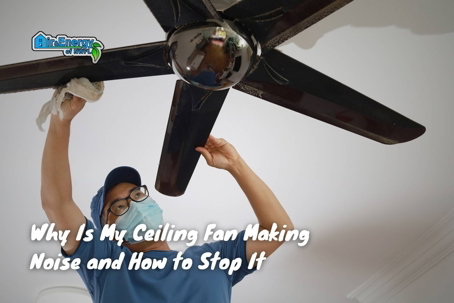Ceiling fans are fantastic for keeping your home cool and comfortable, but that peace can be easily disturbed when a ceiling fan makes noise. Identifying and fixing these issues is crucial to maintaining your fan’s performance and longevity, whether it's a rattling, humming, or clicking sound.
In this article, we’ll explore the common types of ceiling fan noises, how to diagnose them, and practical solutions to fix and prevent them. Addressing fan noise promptly ensures a quieter home and enhances safety and efficiency. Let’s dive in and help you restore tranquility to your living space.
Common Types of Ceiling Fan Noises
Rattling Noise
A rattling noise in your ceiling fan often resembles a constant clinking or tapping caused by loose parts or debris. To fix this, turn off the fan and inspect it closely.
Tighten any loose screws or bolts and remove any debris. Check the blades for imbalances or warping, which can also cause rattling. Regular maintenance, like cleaning and tightening parts, can prevent these issues.
Humming Noise
A humming noise is typically a low, continuous sound that indicates electrical issues or motor problems. Check the wiring connections for loose or frayed wires.
Inspect the capacitor for damage and replace it if necessary to prevent stress on the motor. Lubricating the motor bearings might help if the noise is due to friction. If these steps don’t solve the problem, consult a professional electrician.
Clicking Noise
Clicking noises from a ceiling fan are often due to imbalanced blades or faulty components like blade holders. Check the blades for warping or damage and ensure they are securely fastened.
Use a blade balancing kit if necessary. Sometimes, the clicking noise can come from a loose light fixture attached to the fan, so ensure everything is tightened.
Buzzing Noise
Buzzing noises are usually linked to electrical interference or motor issues. Inspect the fan’s electrical connections for loose wires or faulty connections. Check the motor for wear or lack of lubrication.
Applying lubrication to the motor bearings can reduce friction and eliminate the buzzing sound. If the problem persists, consult a professional for advanced troubleshooting.
Diagnosing the Noise

Visual Inspection
To visually inspect your ceiling fan, first turn off the power. Look for loose screws or bolts and tighten them using a screwdriver. Check for debris caught in the fan blades or motor housing and remove it.
Examine the blades for warping or imbalance. Use a flashlight for better visibility, and consider using a ladder to safely access all parts of the fan. Regular visual checks can help prevent noise issues before they become problematic.
Listening Test
Conducting a listening test can help pinpoint the type and source of the noise. Turn on the fan and stand a few feet away, listening carefully to identify the noise. Note if the noise changes with different fan speeds.
Use a stethoscope or a long screwdriver to listen closely to the motor and other components. This method helps isolate whether the noise is electrical, mechanical, or related to blade balance. Record the noise to analyze later or compare it with similar issues online.
Isolating the Problem
Isolating the noise source involves turning off the fan and manually rotating the blades. Listen for any unusual sounds or resistance.
Advanced techniques include removing the fan blades individually to see if the noise stops, indicating an issue with a specific blade or component. Additionally, check the motor housing and mounting bracket for any loose parts or misalignments.
Solutions for Fixing Noisy Ceiling Fans
Tightening Loose Parts
To eliminate noise from loose parts, gather tools like a screwdriver and pliers. First, turn off the fan and ensure it's not moving. Check all visible screws and bolts, especially on the blades and motor housing, and tighten them.
Ensure all connections are secure. For screws that frequently loosen, use thread-locking adhesive. Regularly check and tighten these parts to maintain a noise-free fan.
Cleaning and Lubricating the Fan
Cleaning and lubricating your ceiling fan can significantly reduce noise. Use a microfiber cloth and a mild cleaning solution to wipe down the blades and motor housing.
Apply a few drops of light machine oil to the motor bearings for lubrication. Ensure the lubricant is compatible with your fan model. Clean and lubricate the fan every six months to keep it running smoothly and quietly.
Balancing the Fan Blades
Balancing the fan blades involves a step-by-step process. Turn off the fan and use a balancing kit, which typically includes a plastic clip and adhesive weights. Attach the clip to a blade, turn on the fan, and note any wobbling.
Move the clip to different blades until the wobble decreases, then apply the adhesive weight to the corresponding blade. Mark the clip's initial position for reference to help streamline the process.
Electrical Fixes
Loose wiring and faulty connections are common electrical issues that cause noise. Turn off the power, remove the fan housing, and inspect the wiring. Tighten any loose connections and ensure wires are securely connected.
Check the capacitor and switch for damage. If unsure, call a professional electrician to avoid risks. Regularly inspect electrical components to prevent noise and ensure safety.
Preventive Measures to Avoid Ceiling Fan Noise
To maintain a quiet ceiling fan, follow these preventive measures:
- Proper Installation: Ensure the fan is securely mounted and all components are tightened.
- Regular Cleaning: Clean the blades and motor housing every few months to prevent debris buildup.
- Lubrication: Lubricate the motor bearings annually to keep them running smoothly.
- Select Quiet Fans: Choose ceiling fans designed for quiet operation to minimize noise.
- Blade Balance: Check the fan blades for balance regularly and use a balancing kit if necessary.
- Reduce Vibration: Install rubber or felt washers between the fan and the mounting bracket to reduce vibration noise.
- Inspect Electrical Connections: Periodically check electrical connections to ensure they are tight and secure, avoiding any humming or buzzing sounds.
By following these preventive measures, you can maintain a quiet and efficient ceiling fan, enhancing the comfort of your home. Regular upkeep prevents noise and extends the lifespan of your ceiling fan, ensuring long-term performance and satisfaction.
❄️ Conclusion

Addressing ceiling fan noises promptly is crucial for maintaining your fan’s efficiency and your home’s comfort. We’ve covered the common types of noises, how to diagnose them, and practical solutions like tightening loose parts, cleaning, lubricating, balancing blades, and fixing electrical issues.
Regular maintenance and timely troubleshooting can prevent these problems from escalating. If you’re ever unsure or the noise persists, don’t hesitate to consult a professional.
For those in Pensacola, FL, reliable HVAC maintenance services are available to help you keep your ceiling fans and other systems in top shape. Take action today to ensure a quieter, more comfortable living space. Contact Air and Energy of NWFL now for expert assistance!

This article was written by:
Co-founder and Home Comfort Specialist

